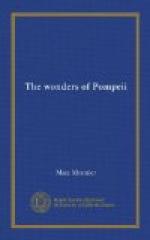Other shops have had their story written by the articles that they contained when they were found. Thus, when there were discovered in a suite of rooms opening on the Street of Herculaneum, certain levers one of which ended in the foot of a pig, along with hammers, pincers, iron rings, a wagon-spring, the felloe of a wheel, one could say without being too bold that there had been the shop of a wagon-maker or blacksmith. The forge occupied only one apartment, behind which opened a bath-room and a store-room. Not far from there a pottery is indicated by a very curious oven, the vault of which is formed of hollow tubes of baked clay, inserted one within the other. Elsewhere was discovered the shop of the barber who washed, brushed, shaved, clipped, combed and perfumed the Pompeians living near the Forum. The benches of masonry are still seen where the customers sat. As for the dealers in soap, unguents, and essences, they must have been numerous; their products supplied not only the toilet of the ladies, but the religious or funeral ceremonies, and after having perfumed the living, they embalmed the dead. Besides the shops in which the excavators have come suddenly upon a stock of fatty and pasty substances, which, perhaps, were soaps, we might mention one, on the pillar of which three paintings, now effaced, represented a sacrificial attendant leading a bull to the altar, four men bearing an enormous chest around which were suspended several vases; then a body washed and anointed for embalming. Do you understand this mournful-looking sign? The unguent dealer, as he was called, thus made up the body and publicly placarded it.
From the perfumery man to the chemist is but a step. The shop of the latter tradesman was found—so it is believed, at all events in clearing out a triple furnace with walled boilers. Two pharmacies or drug-stores, one in the Street of Herculaneum, the other fronting the Chalcidicum, have been more exactly designated not only by a sign on which there was seen a serpent (one of the symbols of AEsculapius) eating a pineapple, but by tablets, pills, jars, and vials containing dried-up liquids, and a bronze medicine chest divided into compartments which must have contained drugs. A groove for the spatula had been ingeniously constructed in this curious little piece of furniture.
Not far from the apothecary lived the doctor, who was an apothecary himself and a surgeon besides, and it was in his place that were discovered the celebrated instruments of surgery which are at the museum, and which have raised such stormy debates between Dr. Purgon and Dr. Pancratius. The first, being a doctor, deemed himself competent to give an account of these instruments, whereat the second, being an antiquary, became greatly irritated, seeing that the faculty, in his opinion, has nothing to do with archaeology. However that may be, the articles are at the museum, and everybody can look at them. There is a forceps,




